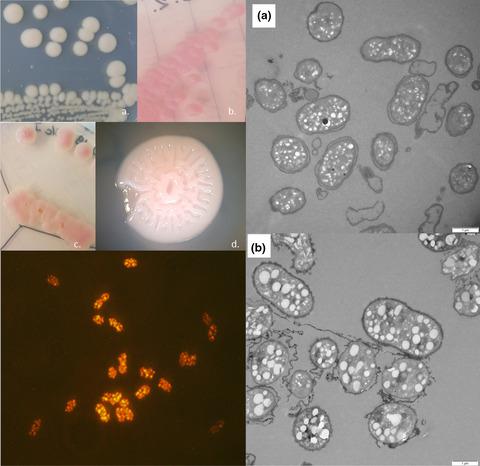当前位置:
X-MOL 学术
›
Microbiologyopen
›
论文详情
Our official English website, www.x-mol.net, welcomes your feedback! (Note: you will need to create a separate account there.)
Complete genome sequence of Photobacterium ganghwense C2.2: A new polyhydroxyalkanoate production candidate
MicrobiologyOpen ( IF 3.4 ) Pub Date : 2021-05-01 , DOI: 10.1002/mbo3.1182 Irina Lascu 1 , Ioana Mereuță 1 , Iulia Chiciudean 1 , Hilde Hansen 2 , Sorin Marius Avramescu 3 , Ana-Maria Tănase 1 , Ileana Stoica 1
MicrobiologyOpen ( IF 3.4 ) Pub Date : 2021-05-01 , DOI: 10.1002/mbo3.1182 Irina Lascu 1 , Ioana Mereuță 1 , Iulia Chiciudean 1 , Hilde Hansen 2 , Sorin Marius Avramescu 3 , Ana-Maria Tănase 1 , Ileana Stoica 1
Affiliation

|
Polyhydroxyalkanoates (PHAs) are biodegradable bioplastics that can be manufactured sustainably and represent a promising green alternative to petrochemical‐based plastics. Here, we describe the complete genome of a new marine PHA‐producing bacterium—Photobacterium ganghwense (strain C2.2), which we have isolated from the Black Sea seashore. This new isolate is psychrotolerant and accumulates PHA when glycerol is provided as the main carbon source. Transmission electron microscopy, specific staining with Nile Red visualized via epifluorescence microscopy and gas chromatography analysis confirmed the accumulation of PHA. This is the only PHA‐producing Photobacterium for which we now have a complete genome sequence, allowing us to investigate the pathways for PHA production and other secondary metabolite synthesis pathways. The de novo assembly genome, obtained using open‐source tools, comprises two chromosomes (3.5, 2 Mbp) and a megaplasmid (202 kbp). We identify the entire PHA synthesis gene cluster that encodes a class I PHA synthase, a phasin, a 3‐ketothiolase, and an acetoacetyl‐CoA reductase. No conventional PHA depolymerase was identified in strain C2.2, but a putative lipase with extracellular amorphous PHA depolymerase activity was annotated, suggesting that C2.2 is unable to degrade intracellular PHA. A complete pathway for the conversion of glycerol to acetyl‐CoA was annotated, in accordance with its ability to convert glycerol to PHA. Several secondary metabolite biosynthetic gene clusters and a low number of genes involved in antibiotic resistance and virulence were also identified, indicating the strain's suitability for biotechnological applications.
中文翻译:

江华发光杆菌 C2.2 的完整基因组序列:一种新的聚羟基脂肪酸酯生产候选者
聚羟基脂肪酸酯 (PHA) 是可生物降解的生物塑料,可以可持续生产,是石化塑料的一种有前途的绿色替代品。在这里,我们描述了一种新的海洋 PHA 生产细菌——光杆菌 ganghwense(菌株 C2.2)的完整基因组,该细菌是我们从黑海海滨分离出来的。这种新分离物具有耐冷性,当甘油作为主要碳源时会积累 PHA。透射电子显微镜、通过落射荧光显微镜观察的尼罗红特异性染色和气相色谱分析证实了 PHA 的积累。这是我们现在拥有完整基因组序列的唯一产生 PHA 的发光杆菌,使我们能够研究 PHA 生产途径和其他次级代谢物合成途径。使用开源工具获得的从头组装基因组包含两条染色体(3.5,2 Mbp)和一个巨质粒(202 kbp)。我们鉴定了编码 I 类 PHA 合酶、菜素、3-酮硫解酶和乙酰乙酰辅酶 A 还原酶的整个 PHA 合成基因簇。在菌株 C2.2 中没有鉴定出传统的 PHA 解聚酶,但注释了具有细胞外无定形 PHA 解聚酶活性的推定脂肪酶,表明 C2.2 不能降解细胞内 PHA。根据甘油转化为 PHA 的能力,注释了甘油转化为乙酰辅酶 A 的完整途径。还鉴定了几个次级代谢物生物合成基因簇以及少量涉及抗生素抗性和毒力的基因,表明该菌株适合生物技术应用。
更新日期:2021-05-02
中文翻译:

江华发光杆菌 C2.2 的完整基因组序列:一种新的聚羟基脂肪酸酯生产候选者
聚羟基脂肪酸酯 (PHA) 是可生物降解的生物塑料,可以可持续生产,是石化塑料的一种有前途的绿色替代品。在这里,我们描述了一种新的海洋 PHA 生产细菌——光杆菌 ganghwense(菌株 C2.2)的完整基因组,该细菌是我们从黑海海滨分离出来的。这种新分离物具有耐冷性,当甘油作为主要碳源时会积累 PHA。透射电子显微镜、通过落射荧光显微镜观察的尼罗红特异性染色和气相色谱分析证实了 PHA 的积累。这是我们现在拥有完整基因组序列的唯一产生 PHA 的发光杆菌,使我们能够研究 PHA 生产途径和其他次级代谢物合成途径。使用开源工具获得的从头组装基因组包含两条染色体(3.5,2 Mbp)和一个巨质粒(202 kbp)。我们鉴定了编码 I 类 PHA 合酶、菜素、3-酮硫解酶和乙酰乙酰辅酶 A 还原酶的整个 PHA 合成基因簇。在菌株 C2.2 中没有鉴定出传统的 PHA 解聚酶,但注释了具有细胞外无定形 PHA 解聚酶活性的推定脂肪酶,表明 C2.2 不能降解细胞内 PHA。根据甘油转化为 PHA 的能力,注释了甘油转化为乙酰辅酶 A 的完整途径。还鉴定了几个次级代谢物生物合成基因簇以及少量涉及抗生素抗性和毒力的基因,表明该菌株适合生物技术应用。


























 京公网安备 11010802027423号
京公网安备 11010802027423号